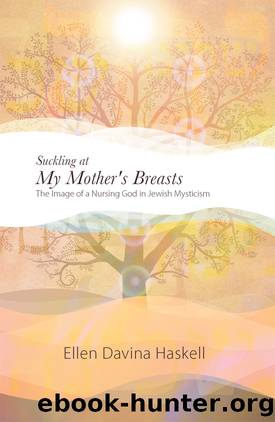Suckling at My Mother's Breasts by Haskell Ellen Davina;

Author:Haskell, Ellen Davina; [Baroni]
Language: eng
Format: epub
ISBN: 3408670
Publisher: State University of New York Press
Published: 2012-10-29T00:00:00+00:00
The Nursing Divine and the Question of Religious Influence
Negative response was not the kabbalists' only reaction to Christian ideas. Emphasis on divine femininity was one of Kabbalah's greatest innovations, yet kabbalistic images like the divine nursing mother were developed in the context of similar Christian theological trends. Both Peter Schäfer and Arthur Green have suggested a direct influence between Kabbalah's late-twelfth-century female divine imagery and the cult of Mary's rise in Western Europe.41 During the twelfth century, Christian theologians increased their use of feminine religious language, producing texts that included images of the Virgin similar to Kabbalah's descriptions of Shekhinah.42 Feminine religious imagery was invoked not only in Marian theology, but also in depictions of Jesus as mother, Ecclesia as mother, and male clerical authority figures as mothers.43 All of these representations could appear in conjunction with suckling imagery.44
As in Jewish theology, Christian breastfeeding metaphors provided models for understanding the relationships between divinity and humanity. Bernard of Clairvaux (1091â1153), founder of the Cistercian Order (who, according to a popular medieval legend, suckled from the breasts of the Virgin herself) developed a theology in which Jesus nursed the Ecclesia, who then breastfed Christians with religious influence. Bernard's suckling represented a flow of instruction or affectivity, invoking a metaphor for spiritual transmission similar to Kabbalah's nursing divine.45 Other Christian theologians such as William of St. Thierry (ca 1085â1148) also used suckling imagery to express religious knowledge's transmission between the Church and humanity.46 The twelfth century Cistercian Adam of Perseigne maintained that when human souls suckled at the Virgin's breasts they became Jesus' spiritual siblings, an idea paralleled in chapter 1's rabbinic texts about Sarah.47 By the thirteenth century, images of the lactating Virgin began to grow popular in Christian art, and Marian theology had become a focal point for Christian lay leaders.48 Corresponding to its appearance among the exclusively masculine kabbalists, Christian suckling imagery was associated primarily with male clergy members rather than with female mystics or cloistered women.49
Within this context, Ezra of Gerona's Commentary on the Song of Songs is of particular interest. Ezra's was the first kabbalistic commentary on the Song, and his excursion into Song exegesis paralleled Christian exegetical developments.50 As focus on feminine imagery grew in the twelfth century, Christian writers began to interpret the Song of Songs from a Marian perspective, understanding it as a loving dialogue between Jesus and his holy mother. Until that point, the Song had been interpreted as a conversation between Jesus and the human soul or between Jesus and the Church, ideas roughly parallel to Jewish readings of the Song as a dialogue between God and the Israelite people.51 Christian Song interpretations that encouraged reverence of Jesus and Mary continued to be composed throughout the thirteenth century, gradually disappearing between the fourteenth and fifteenth centuries. Jewish Song interpretation paralleled its Christian counterpart both chronologically and thematically.52 Both groups' literature made notable use of feminine figures and female breast imagery.53
Along with Marian devotion's emergence in twelfth century Europe, an increased emphasis on affective spirituality also occupied Christian exegetes.
Download
This site does not store any files on its server. We only index and link to content provided by other sites. Please contact the content providers to delete copyright contents if any and email us, we'll remove relevant links or contents immediately.
| Hebrew Bible (Old Testament) | Talmud |
| Torah | Zohar |
The Secret Power of Speaking God's Word by Joyce Meyer(2750)
Man's Search for Meaning by Viktor E. Frankl(2555)
Mckeown, Greg - Essentialism: The Disciplined Pursuit of Less by Mckeown Greg(2333)
MOSES THE EGYPTIAN by Jan Assmann(2275)
Devil, The by Almond Philip C(2204)
Unbound by Arlene Stein(2179)
The Complete Dead Sea Scrolls in English (7th Edition) (Penguin Classics) by Geza Vermes(2135)
I Capture the Castle by Dodie Smith(1905)
Schindler's Ark by Thomas Keneally(1760)
The Invisible Wall by Harry Bernstein(1706)
The Gnostic Gospel of St. Thomas by Tau Malachi(1677)
The Bible Doesn't Say That by Dr. Joel M. Hoffman(1608)
The Secret Doctrine of the Kabbalah by Leonora Leet(1526)
Political Theology by Carl Schmitt(1501)
The Jewish State by Theodor Herzl(1470)
A History of the Jews by Max I. Dimont(1439)
The Dead Sea Scrolls Bible by Martin G. Abegg(1425)
The Book of Separation by Tova Mirvis(1419)
Oy!: The Ultimate Book of Jewish Jokes by David Minkoff(1293)
